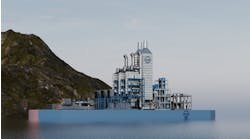PLATFORM DECOMMISSIONING: Stabilization elements to consider in re-floating concrete gravity platforms
Due to their vast size, the removal of redundant deepwater structures from the North Sea will require massive feats of engineering if companies comply with OSPAR 98/3 (see Beyond the Horizon, November 2000 issue). Several huge complex vessels with lift capacities well beyond the traditional crane barge have been proposed, but could simpler and still effective buoyancy aids be a cheaper and safe alternative?
The small fleet of giant semisubmersible crane barges is already about 20 years old. Will those vessels be replaced, and if so, can the ultimate lifting capacity be raised above the current 14,000 tons? Apart from the obvious parameters of crane outreach and upreach, how much lift capacity would the industry like to have ? This affects not only the strength of the component parts of the lifting system, but impacts upon ship's static stability with an even heavier and higher suspended load.
Safety factor
In order to select or specify an installed lifting capacity, what safety (or is it uncertainty) factor shall we apply after deciding the maximum load we wish to lift? We must consider through-water drag and marine growth if it is an underwater jacket structure, as well as wind load effects, acceleration against gravity, and dynamic handling effects, which also contribute to "g."
If we assume that conventional crane barges have reached their ultimate lifting limit, we must be prepared either to cut the structure into smaller pieces (thereby spoiling the chance of re-use), or turn to other floating craft, for which several expensive devices have been proposed. Yet there are other simpler and probably cheaper ways of lifting a steel jacket off the seabed and taking it back to shore, or dumping it in deepwater (prohibited by OSPAR).
Re-flotation
The principles associated with the flotation of underwater structures will be thoroughly familiar to naval architects and marine technologists. But for the many people with other disciplines who may be involved in a platform recovery project, from inception through planning and onwards into implementation, all should be aware of the safety issues involved and mindful of what might go astray.
Many uncertainties may exist in accurately determining some of the forces and the associated points at which they act. This might give rise to unexpected instability of a refloating structure and cause loss of control before it is safely on the surface, ready for tow to shore or dismantling station.
Structures, whether simple spar buoys or complex space-frame steel jacket structures, have principal static stability features (Figure 1). The center of buoyancy (B in Figure 1) is the center of the underwater volume and the single point through which all the buoyancy force is considered to act upwards.
That point is defined by three coordinates - above base, vertically, and horizontally. When the shape of the underwater volume changes, for instance as a jacket breaks the surface or inclines during its upward trajectory, then the position of B will shift.
Similarly, the center of gravity (G) is the single three-coordinate point through which the weight of a structure will act vertically downwards. Unless items fall off the structure or there is a change in the ballast content during the uplift, G remains fixed.
However, the distribution of platform weight may not be known with certainty, due to structural modification over the years. Also, there are other questions:
- How much marine growth may be attached
- Have any tubular members lost watertight integrity.
Before we consider the vital issue of the position of the metacentre (M), note that the effective stability is measured by metacentric height (GM), which is the sum of the distances KB, plus BM, less KG. Lessening BM reduces GM, which must remain positive at all phases of re-flotation or the unstable structure may incline uncontrollably.
Now, the distance BM is defined by the moment of inertia I (or second moment of area) of the waterplane, divided by the total volume of buoyancy. Both change as a structure rises, possibly resulting in tilting of the re-floated structure as it rises through the water column (Figure 2).
Stability coordinates
A space frame jacket structure will have its point B somewhere in space. However, the point M is not a single entity since the actual value of I will depend on the axis of rotation and the distribution of the areas which contribute to the overall waterplane area.
Accordingly, GM may be less in some directions than in others. For example, during installation of the Thistle jacket in the UK sector of the North Sea, the structure was deliberately rotated by ballasting, in order to "improve" the value of GM at a certain stage of the sinking.
Furthermore, during a re-flotation exercise for a hypothetical structure, the total weight of structure with adjustable ballast should be almost equal to the buoyancy upthrust at each attitude. Note that the position of "G" would be affected if mud or other alien material is left stuck to the perimeter of the structure.
Buoyancy aids
Buoyancy aids have been used in salvage work for many years, but if a "soft" shell is used, the volume of buoyancy, and hence upthrust, is affected by changing water pressure. Hard shell tanks are heavier to deploy.
Experiments conducted at Southampton investigated the quantity of buoyancy as a percentage of jacket weight, different distributions of buoyancy aids around the jacket as well as their initial position of submergence.
The Institute also made observations of accidental loss of buoyancy contribution, and by through-water video, observed the trajectory of the ascending model up to its free-floating attitude at the surface. Not only would we like to see these tests extended, but also to try them on a small, but full size, jacket.
To this end, some research and development work is underway by a company developing controllable buoyancy cylinders, which may be attached to structural members of a jacket.
Attachable and re-usable buoyancy devices could provide cheaper option for the recovery of the large steel jackets in a single piece, without cutting in mid-water as well as near the mud-line. By carefully filling or emptying ballast tanks the in-water attitude of the jacket can be controlled at all times, perhaps enabling the jacket to be raised sufficiently out of the water and so achieve a shallow draught for entering constricted waters where other currently envisaged vehicles could not go.
Author
William Penney is the Associate Professor of Offshore Operations at Southampton Institute.





